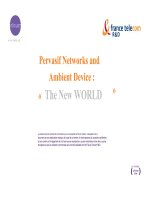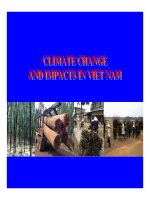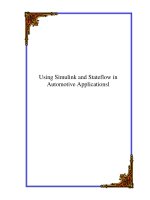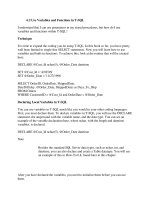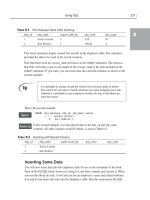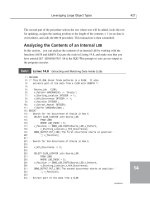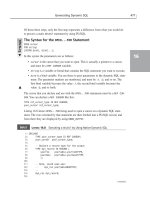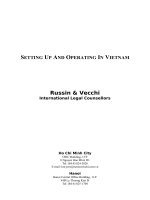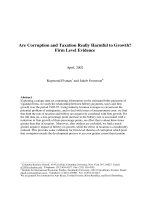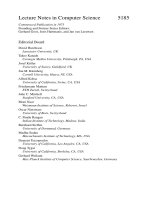Tài liệu Power, Politics and Identity in South African media docx
Bạn đang xem bản rút gọn của tài liệu. Xem và tải ngay bản đầy đủ của tài liệu tại đây (4.33 MB, 416 trang )
Free download from www.hsrcpress.ac.za
Free download from www.hsrcpress.ac.za
EDITED BY ADRIAN HADLAND, ERIC LOUW, SIMPHIWE SESANTI & HERMAN WASSERMAN
SELECTED SEMINAR PAPERS
Free download from www.hsrcpress.ac.za
Published by HSRC Press
Private Bag X9182, Cape Town, 8000, South Africa
www.hsrcpress.ac.za
First published 2008
ISBN 978-0-7969-2202-1
© 2008 Human Sciences Research Council
The views expressed in this publication are those of the authors. They do not necessarily
reflect the views or policies of the Human Sciences Research Council (‘the Council’)
or indicate that the Council endorses the views of the authors. In quoting from this
publication, readers are advised to attribute the source of the information to the
individual author concerned and not to the Council.
Copyedited by Lisa Compton and Karen Press
Typeset by Jenny Wheeldon
Cover design by Fuel Design
Print management by comPress
Distributed in Africa by Blue Weaver
Tel: +27 (0) 21 701 4477; Fax: +27 (0) 21 701 7302
www.oneworldbooks.com
Distributed in Europe and the United Kingdom by Eurospan Distribution Services (EDS)
Tel: +44 (0) 20 7240 0856; Fax: +44 (0) 20 7379 0609
www.eurospanbookstore.com
Distributed in North America by Independent Publishers Group (IPG)
Call toll-free: (800) 888 4741; Fax: +1 (312) 337 5985
www.ipgbook.com
Free download from www.hsrcpress.ac.za
Contents
Abbreviations and acronyms vii
1 Introduction 1
Adrian Hadland, Eric Louw, Simphiwe Sesanti and Herman Wasserman
Identity in theory
2 Media, youth, violence and identity in South Africa: A theoretical
approach 17
Abebe Zegeye
3 Essentialism in a South African discussion of language and culture 52
Kees van der Waal
4 ‘National’ public service broadcasting: Contradictions and dilemmas 73
Ruth Teer-Tomaselli
5 Field theory and tabloids 104
Ian Glenn and Angie Knaggs
6 Identity in post-apartheid South Africa: ‘Learning to belong’ through
the (commercial) media 124
Sonja Narunsky-Laden
Media restructuring and identity formation after apartheid
7 Finding a home in Afrikaans radio 151
Johannes Froneman
8 The rise of the Daily Sun and its contribution to the creation of
post-apartheid identity 167
Nicola Jones, Yves Vanderhaeghen and Dee Viney
9 Online coloured identities: A virtual ethnography 184
Tanja Bosch
Free download from www.hsrcpress.ac.za
10 The mass subject in Antjie Krog’s Country of My Skull 204
Anthea Garman
Expressing identities
11 Crime reporting: Meaning and identity making in the South African
press 223
Marguerite J Moritz
12 Afrikaner identity in post-apartheid South Africa: The Self in terms of
the Other 239
Wiida Fourie
13 Foreign policy, identity and the media: Contestation over Zimbabwe 290
Anita Howarth
14 Masculine ideals in post-apartheid South Africa: The rise of men’s
glossies 312
Stella Viljoen
15 Tsotsis, Coconuts and Wiggers: Black masculinity and contemporary
South African media 343
Jane Stadler
16 The media and the Zuma/Zulu culture: An Afrocentric perspective 364
Simphiwe Sesanti
17 Black masculinity and the tyranny of authenticity in South African
popular culture 378
Adam Haupt
Contributors 399
Free download from www.hsrcpress.ac.za
vii
Abbreviations and acronyms
AMPS All Media and Products Survey
ANC African National Congress
BBC British Broadcasting Corporation
CODESA Congress for a Democratic South Africa
COSATU Congress of South African Trade Unions
CP Conservative Party
DA Democratic Alliance
DSTV digital satellite television
IBA Independent Broadcasting Authority
ICASA Independent Communication Authority of South Africa
LSM Living Standards Measure
MDC Movement for Democratic Change (Zimbabwe)
NP National Party
RSG radiosondergrense
SABC South African Broadcasting Corporation
SACP South African Communist Party
SANEF South African National Editors Forum
TRC Truth and Reconciliation Commission
Free download from www.hsrcpress.ac.za
Free download from www.hsrcpress.ac.za
1
Introduction
Adrian Hadland, Eric Louw, Simphiwe Sesanti and Herman Wasserman
The second decade of democracy in South Africa has created a sufficient
distance for media scholars to look back on what has been achieved and to
begin to understand and critique the trends and developments that have
transpired in the years since the abolishment of apartheid in 1994. It is true
that the media, like South African society itself, have undergone massive
changes in this period. The liberalisation of the broadcast sector, the arrival of
the tabloids, the growth of the Internet and significant shifts in the ownership
patterns of media organisations are sufficient evidence of the predominance
of change. But, again as in society itself, there are some areas of the media
where change has been lacking or minimal. Some of these areas are the
participation of women in the media, where the status quo has remained
stubbornly resistant, as well as the terms on which the voices of black youth
are heard in mainstream media. A study of the South African media post-
1994 must therefore tread carefully so as to explore the interesting and often
unpredictable ways in which change has been taking place while at the same
time not be so celebratory of change that persisting challenges and problems
get overlooked.
This ‘double moment’ of change and continuity can also be noted in studies of
South African identity post-1994. Alexander (2006: 13) refers to two opposing
views of South African identity after apartheid. The one view is that the
social landscape of South Africa has changed to such an extent that identities
have become fluid, changing and hybrid. On the other hand, as Alexander
shows, scholars like Zegeye (2001) maintain ‘a primary concern with political
identity’ after apartheid (Alexander 2006: 14). This dualism becomes clear in
the ways in which specifically the category of ‘race’ in post-apartheid society
has been studied. Nuttall (2006) identifies two streams of race studies. The
first, and dominant, stream consists of work ‘paying renewed attention to
racism and identity’. This work, exemplified by Wasserman and Jacobs (2003)
and Zegeye (2001), ‘focuses on hidden, invisible forms of racist expression
and well-established patterns of racist exclusion that remain unaddressed and
uncompensated for, structurally marking opportunities and access, patterns
1
Free download from www.hsrcpress.ac.za
POWER, POLITICS AND IDENTITY IN SOUTH AFRICAN MEDIA
2
of income and wealth, privilege and relative power’ (Nuttall 2006: 271). The
second stream of race studies, into which Nuttall categorises the work of
Achille Mbembe (2004) and others, draws on discourses of ‘multiculturalism’
that simultaneously acknowledge the history of ‘race thinking’ and attempt
to move beyond it. The latter type of study aims to highlight the agency
exercised by actors in reshaping their identities, especially in assuming a role
as consumers in the market economy. The increasing emergence of consumer
identity, especially among young South Africans, is also a development
identified by Alexander (2006: 60).
The renegotiation of identity in the contemporary South African context,
whether in terms of a re-emergence of old identities (Alexander 2006: 39) or
as part of ‘new ways of imagining’ (Nuttall & Michael 2000), takes place at
the intersection of the local and the global. On the one hand, the influence of
‘supranational forces’ (Alexander 2006: 37) on the formation of identity has
been marked; on the other hand, shifts in local discourses have led to different
notions of citizenship, nationhood and cultural identity emerging in the post-
apartheid period. These two sources of influence on identity formation should
not be seen as separate – rather, the global and the local often overlap or feed
off each other. While the consolidation of local identities frequently takes
place in reaction against the perceived threat of ‘McDonaldisation’, discourses
such as the ‘African Renaissance’ also position the construction of South
African identity within a broader pan-African sphere of influence. The latter
discourse, supported by President Thabo Mbeki, can be seen as a reassertion
of African identity that represents a move away from the conception of the
‘rainbow nation’ that was the ‘leitmotif of Nelson Mandela’s presidency’
(Alexander 2006: 40).
From the above overview it becomes clear that the study of identity and
culture in post-apartheid South Africa has yielded multiple and often
divergent insights. These concerns remain important for scholarship aimed
at understanding the rapid and often complex shifts taking place in South
African society, political life and cultural formations. However, while the
media have emerged as important role-players in all these areas, they are still
often relegated to a marginal position in identity studies as well as within the
broader terrain of cultural studies. When the media do enter the discussion,
they are mostly treated as textual artefacts containing representations of
identity categories such as gender or race, rather than in terms of their
implication in broader social, political and economic processes.
Free download from www.hsrcpress.ac.za
INTRODUCTION
3
If identity studies have diverged, as shown above, into a study of the emergence
of new hybrid forms on the one hand and a study of the continuity of structural
impediments mitigating against them on the other, the study of journalism and the
media has equally been divided between structure and agency. Scholarly debates
around the media’s position in post-apartheid society have tended to focus either
on structural shifts and continuities (by studying, for example, the media’s place
in the political economy of the transition; ownership and editorial changes; and
the media’s relationship with civil society); professional issues (usually taking the
form of reiterations of functional orthodoxy, such as the media’s role as ‘watchdog
of government’ or protector of the ‘public interest’); or symbolic dimensions (of
which the representation of race and gender has enjoyed particular attention).
These different aspects have until now seldom been connected. This collection
of essays is intended as an exploration of these intersections. It brings together
perspectives on the media’s role in the transition that interrogate the relationships
between identity discourses and political power, between new subjectivities and
persisting legacies of apartheid, and between new narratives of nationhood and
the increased commercialisation and privatisation of the public sphere. While this
exploration takes the local specificity of South Africa as its point of departure,
it remains aware of the acceleration of globalisation facilitated largely through
the media. While the focus falls on the era after apartheid, it strives towards
understanding contemporary developments against a wider historical backdrop.
In doing so, the collection aims to investigate how the media’s construction of
identity in post-apartheid South Africa is inextricably linked with the politics of
the transition in all its multifarious dimensions.
This collection of essays – many of which were presented at an international
conference in Stellenbosch on the same theme in July 2006 – came about
as a project to excavate the space between media and identity. The media,
of course, have many forms, just as identity has many variations. Their
interrelationship is a complex, shifting matrix as difficult to narrow down as
it is important to the people who find their meaning within it. The media do
generate, corroborate and accelerate identity formation, just as they diminish,
overshadow and negate it. The variety of essays included in this volume reflects
the various forms this process has taken during the first decade and more of
democracy in South Africa.
South Africa offers a rich context for the study of the interrelationship between
media and identity because its recent emergence as a democracy out of the
quagmire of profound racial conflict, as well as the history of that conflict, has
Free download from www.hsrcpress.ac.za
POWER, POLITICS AND IDENTITY IN SOUTH AFRICAN MEDIA
4
been closely tied to the role of its sophisticated media sector. During apartheid,
large sections of the media were complicit in the legitimation of the ruling
class’s logic of separateness, or what Zegeye (2001: 1) has called ‘imposed
ethnicity’. Some media, however, also played a role in the resistance against
apartheid. With the shift to democracy, the South African media have had to
reposition themselves ideologically, politically and culturally. The influence
this repositioning has had on the shaping of new identities in this period is
investigated from various angles in this volume.
The essays are organised into three sections. In the first section, ‘Identity in
theory’, contemporary theories relating to media and identity are interrogated
and applied to the South African context. In his chapter ‘Media, youth, violence
and identity in South Africa’, Abebe Zegeye draws on notions of the ‘subaltern’
in postcolonial theory, especially as it has been developed by Gayatri Spivak,
to show how the legacy of the youth protests against apartheid led to their
silencing in scholarship. Challenging what he calls ‘elitist sociology’, Zegeye
investigates a number of structural conditions within which the identities of
the youth of South Africa today are formed.
In his discussion of essentialism, Kees van der Waal emphasises the challenge
to studies of identity, culture and language to ‘probe for the assumptions
underlying the discourses that form part of the encounters in this field’ and to
pay attention to human interactions and the context of events. Van der Waal’s
injunction against essentialism is a vital warning that fittingly frames the
chapters to follow, given the dangerous tendency to homogenise and lapse
into binary thinking when investigating identity issues in a context marked by
a history of systemic polarisation, as was the case in South Africa. Van der Waal
reminds us that ‘[a]ll forms of essentialism need to be questioned and seen as
political attempts to frame constructions in a specific way, based on a set of
interests and relationships’.
The normative theoretical concept of the ‘public sphere’ developed by Jürgen
Habermas has become one of the standard theories by which the role of
the media in contemporary society has come to be described. Ruth Teer-
Tomaselli, in her study of the relationship between the public broadcaster, the
public, the nation and the state, problematises the way that this concept ‘has
been applied to media with an almost canonical reverence’. She points out
how the confluence of South Africa’s democratising process and accelerated
globalisation has put the South African public broadcaster in a precarious
position. It has to balance the demands to reconstruct national identity after
Free download from www.hsrcpress.ac.za
INTRODUCTION
5
apartheid with the imperatives of a postmodern, globalised media market in
which older notions of the public broadcaster – and therefore also the ‘public
sphere’ – are forced to undergo revision. Public broadcasting in South Africa
has thus become a terrain where the media’s role in constructing identity has
become severely contested.
In the following chapter, the Habermasian concept of the ‘public sphere’, as
well as Benedict Anderson’s well-known notion of the nation as an ‘imagined
community’, is again found not to be suitable for an understanding of
developments in the South African media. In their study of a Cape Town
tabloid, the Daily Voice, Ian Glenn and Angie Knaggs suggest that the field
theory of Pierre Bourdieu provides a better way of understanding the issues of
media and identity in general and the tabloids in particular.
Sonja Narunsky-Laden also draws on the work of Bourdieu to develop a theory of
cultural economy in South African media. Narunsky-Laden points to the salience
of consumer culture in post-apartheid South Africa as a discourse through
which new identities are forged, even as old racialised identities are reactivated
in the context of consumption. She argues for a more dynamic approach to the
formation of identity through media use than that entailed in theories of political
economy or race. She sees the discourses of consumption, consumer culture and
promotional culture as ‘the dominant register of public debate in post-apartheid
South Africa today’. These discourses are important to study because of their
influence on social conduct, aspiration and cultural identity.
The overall impression left by the contributors to the first section of the volume
is that, while investigations of the relationship between media and identity in
post-apartheid South African society should take cognisance of theoretical
approaches that seek to explain this relationship, these approaches should also
be contextualised to fit the imperatives of the local and the contemporary.
The second section of the volume, ‘Media restructuring and identity formation
after apartheid’, explores in more detail this contemporary local context.
South Africa’s media system underwent massive change in the wake of the
country’s political transition from apartheid to democracy in the early 1990s.
Broadcast was the first sphere to experience dramatic transformation with
the deregulation of the state monopoly in the run-up to the 1994 election.
This process was fuelled by political concerns, principally from a liberation
movement and broadcast-rights community hitherto excluded from access
to state-dominated airwaves. The Independent Broadcasting Authority (IBA)
Free download from www.hsrcpress.ac.za
POWER, POLITICS AND IDENTITY IN SOUTH AFRICAN MEDIA
6
Act No. 153 of 1993 was the outcome of broad multi-party negotiations and
established an independent regulatory authority to administer the newly
liberalised airwaves. Within 10 years, almost 100 community radio stations
had been granted licences by the IBA and its successor, the Independent
Communication Authority of South Africa.
In addition, the introduction of a free-to-air television channel (e.tv), the
privatisation of several radio stations that had once fallen under the ambit of
the state-owned South African Broadcasting Corporation, and the arrival of
satellite broadcasting propelled South Africa from a narrow, closely controlled
broadcast sphere into a diverse and largely liberalised zone. This opening of
the airwaves, and the appearance of the voices, languages and agendas therein,
inevitably impacted on the articulation and development of South African
identities. In the first chapter of this section, ‘Finding a home in Afrikaans
radio’, Johannes Froneman provides an overview of the development of the
South African broadcast media together with case studies of two Afrikaans
radio stations, radiosondergrense (RSG) and Radio Pretoria. He asks how
these two very different stations have become sites of struggle in the creation
of meaning for an ethnic and language group stripped of its political power.
Both stations, he finds, are entrenched in their ideological positions vis-à-
vis the new political dispensation. RSG provides a home for an increasingly
mixed racial grouping of Afrikaans speakers who broadly accept the non-racial
imperative of the 1996 Constitution and who recognise the need for cultural
and linguistic diversity. Radio Pretoria, on the other hand, ‘insists on the right
to reject the dominant political paradigm, while pragmatically seeking to find
some minimum accommodation and ensure cultural and economic survival’.
The existence of both stations, and the manner and direction of change in
their audiences, demonstrate the diversity of identity within the Afrikaans
community as well as the challenges and opportunities that this presents to a
responsive broadcast media.
In the print media sector, similarly powerful developments were experienced
with equally important consequences for the manner in which South Africa’s
many communities were represented. The country’s small but influential
alternative press, starved of foreign funds and with little appeal to commercial
advertisers, struggled on into the mid-1990s before collapsing. Only the Mail
& Guardian continues, now with foreign owners rather than overseas funders.
Foreign capital also made its mark on the mainstream print media with the
arrival of Tony O’Reilly’s Independent Newspapers group just before the
Free download from www.hsrcpress.ac.za
INTRODUCTION
7
democratic election of 1994. With African National Congress (ANC) approval,
O’Reilly bought the Argus newspaper group, formerly the country’s largest
collection of print media titles. Nigerian investment also saw the launch of a
new daily in South Africa in 2003, ThisDay. The paper lasted just under a year.
One of the most significant trends of the post-1994 period in the South
African print media was the arrival of tabloid newspapers. In 1994, the biggest
selling daily newspaper – which sold an average of 191 322 copies per day
in the first half of 1994 – was The Star of Johannesburg. By 2006, the Daily
Sun was selling over 450 000 copies a day and had a daily readership of 3.44
million. The arrival of the tabloids, as the authors of the second chapter in
this section point out, sparked fierce controversy among media analysts. At
first, commentators bemoaned the apparently poor journalism of the tabloids
seemingly founded on dodgy ethics and pandering to the lowest common
denominator. Since then, according to Nicola Jones, Yves Vanderhaeghen and
Dee Viney, more critical thought is being given to the impact and importance
of the tabloid phenomenon.
In their chapter on the rise of South Africa’s biggest tabloid, the Daily Sun,
these authors argue ‘while tabloid journalism may have many faults, it can
also be seen as an alternative arena for public discourse’. Within this domain,
new possibilities have been created for the provision of access and for the
representation of citizens previously excluded from mainstream print media
discourse. The authors suggest that the concomitant rise in literacy, in levels
of participation and in the frequency and verisimilitude of self-identification
necessarily supports a deepening of the quality of democracy. They also
explore the relationship between cultural consumption and questions of
cultural identity and investigate, in particular, how the Daily Sun has acted as
a mechanism for identity change by offering ‘tools of identity making’ to its
millions of daily readers.
Racial identity has never had more currency than in the post-apartheid era,
argues Tanja Bosch in her chapter on online coloured identities. And with
the Internet, new possibilities have been created for the exploration and
articulation of these identities. Conducting a virtual ethnography of the
Internet portal Bruin-ou.com, Bosch examines how the meaning of ‘coloured’
is explored on the Internet and how identity is constructed and contested via
the site. She finds that coloured identity is linked more to global notions of
blackness than to a South African black identity: ‘coloured identity is still more
than a dated apartheid label; it has been invented and reinvented’. She argues
Free download from www.hsrcpress.ac.za
POWER, POLITICS AND IDENTITY IN SOUTH AFRICAN MEDIA
8
that the creation of virtual communities in cyberspace facilitates cultural
empowerment as minority groups are able to consolidate their cultural
identities despite geographic borders or other constraints.
An important trend in South African journalism, as well as in the world at
large, has been the shift toward convergence. This process implies both the
presentation of the same or similar content on a range of platforms as well
as the concentration of those platforms into multi-use devices. Examples
include the development of information and news websites by newspaper
companies and the increasing multifunctionality of cellphones. Both trends are
characteristic of the South African media sector in the post-1994 period. Both
also demonstrate how the restructuring of the media has not been simply about
changing ownership patterns, new media platforms or increased diversity. It
has also been underpinned by shifting relationships between media forms
and the manner in which these forms are accessed. In her chapter on Antjie
Krog’s account of her experience of reporting on the Truth and Reconciliation
Commission (TRC), Country of My Skull, Anthea Garman illustrates exactly
this notion and contemplates its implications for identity formation.
The TRC was the most important of the new South African state’s attempts to deal
with the past, Garman writes. Krog’s book combines her own witnessing of the
TRC’s work with personal testimony from perpetrators and victims, and reportage
of behind-the-scenes events and discussions. The product, argues Garman, is a
work of journalism that the traditional journalistic outlets of radio, television
and print could not convey equally well. The book allowed Krog to combine her
skills as a poet with her insights as a reporter to present an understanding of what
happened at the TRC and what it meant for South Africa.
Writer Andre Brink has argued that trying to contemplate the importance
of the TRC would be ‘irresponsible’ without reference to Krog’s text. In her
chapter, which again leans on developments in public-sphere theory, Garman
claims the text of Country of My Skull enables readers to participate in a ‘mass
subjectivity’ that allows for an imaginary but demonstrable notion of national
unity: ‘[I]t is this very construction of public-private subjectivity in relation
to texts that allows for participation in an imagined, public and unknowably
large community.’ The chapter is a reminder that new forms of media are in
the process of being created all the time and with them new avenues for the
articulation, or subjugation, of identities. We therefore need to re-evaluate
constantly the restructuring of the media matrix and of the place of identity
within it.
Free download from www.hsrcpress.ac.za
INTRODUCTION
9
Since 1994 South Africa has experienced a significant transformation of its
political and media landscapes. Not surprisingly, these transformations have
impacted on both collective and individual identities of South Africans. On
the one hand, those identities that had emerged and grown under apartheid
were destabilised by post-1994 hegemonic shifts. On the other hand, the
reconfiguration of the country’s socio-political and media landscape created
the conditions for – and promoted – the emergence of new individual and
collective identities. A complex process of identity construction, deconstruction
and reconstruction has effectively characterised post-apartheid South Africa.
Section three of this volume, ‘Expressing identities’, examines some of these
processes through discussions of various media examples.
The authors contributing to section three have all focused on different
identity formations. Only one author, Simphiwe Sesanti, deploys a form of
perennialism to understand identity, while the other six authors contributing
to this section share a common understanding of the phenomenon of
identity. These six implicitly use constructivism, wherein identity is viewed
as the outcome of a construction process. Sesanti’s chapter thereby offers
an interesting counterpoint to the way the other authors have viewed South
African identity.
Overall, section three offers a series of case studies depicting the tensions and
struggles associated with the birth of new and the mutation of old identities
in contemporary South Africa. The case studies show how old identities have
been reconstructed (or, alternatively, have resisted reconstruction), how new
identities have been constructed out of the resources made available by a
transformed media environment, and how new identities have grown from
appropriating and/or reconfiguring media constructions imported from
America via an increasingly globalised media system. The case studies also
highlight the role of the post-1994 state in constructing new ideologies and
identities, and the relationship of the news media to aspects of South African
identity formation.
The result has been a dynamic environment for the birth of new identities
and the mutation of old identities. If one examines the resultant process of
identity formation and mutation through the case studies in section three, one
is struck by the importance of:
the role played by new (post-1994) media genres which function within the •
logic of neo-liberal globalised economics;
the way in which identities emerge both ‘organically’ (from grass-roots •
Free download from www.hsrcpress.ac.za
POWER, POLITICS AND IDENTITY IN SOUTH AFRICAN MEDIA
10
engagements with the world) and through the ‘organised’ labour of media
professionals;
how individuals construct their identities from the stories and images •
carried in the media, as well as from how they choose to relate to people
around them;
the impact of television and film images imported from America;•
the contradictions between, on the one hand, the preferred discourses of •
progressive media producers and ANC leaders and, on the other, realities
on the ground (these contradictions get encoded into media products
which then impact on identity formation);
the resilience of old identities and ideologies;•
the local context which sets the parameters within which identity formation •
ultimately takes place; and
the contradictions inherent in the contemporary nation-building and •
hegemony-building exercise that South Africa is grappling with, and how
these contradictions impact on identity formation.
When reading these case studies, one is reminded of Karl Marx’s observation
that humans make their own history but are not free to make it as they please.
Humans may be active builders of their worlds and their identities, but they are
simultaneously constrained by existing social, economic and political conditions
and by the weight of the past that is always already encoded into existing
conditions and existing identities. Post-1994 South Africa illustrates all too well
how the world is not a tabula rasa upon which the new can be inscribed afresh.
Wiida Fourie’s analysis of letters to the Beeld newspaper is revealing of how
Afrikaners, in adjusting to the post-apartheid environment, have reconstructed
a number of key elements of their self-identity. Equally significant, Fourie shows
how some core features of Afrikaner identity have remained resistant to change. In
particular, letters to Beeld suggest that Afrikaner perceptions of ‘the other’, as well
as attitudes about how Afrikaners should relate to ‘others’ (i.e. group boundary
maintenance), have remained resistant to change. This mixture of change and
resistance is revealing of the complexity that is identity construction.
Adam Haupt’s analysis of the construction of South African black masculinity
tells us much about the impact of popular culture on identity construction.
In particular, we see the way in which black males are influenced by media
images of African Americans and how these American media-made identities
are both incorporated and reconfigured by South Africans as they construct
their own identities.
Free download from www.hsrcpress.ac.za
INTRODUCTION
11
Significantly, both Fourie’s and Haupt’s work reveals how the processes of
post-apartheid identity reconstruction can be painful – and not only for white
Afrikaners as might have been expected, but also for members of the emergent
black middle class.
Both Haupt and Jane Stadler reveal the significance of images delivered by a
globalised media, and how these global images are appropriated and localised
in a South African context. Stadler’s work unpacks how film images have
simultaneously served to reproduce old identities, construct new identities, and
disseminate and popularise American identities (especially African American
identities) in a South African context. But, most significantly, Stadler’s work
on ‘Coconuts’ and ‘Wiggers’ shows us how South Africans have also subverted,
deconstructed and reconfigured (that is, localised) these identities imported
from America.
Stella Viljoen’s work on South African men’s magazines shows us something
similar: when commercialised global media genres were imported into
South Africa after 1994, they encountered a local context that demanded
modifications. Viljoen’s analysis suggests that identity construction among
Afrikaner and black males requires a significant localisation of the content of
media products. Again we see that, although American-derived media content
is a resource South Africans do use in constructing their identities, it is an
appropriation that often localises and modifies such content.
Anita Howarth’s approach to identity is different from the other contributions
insofar as it focuses on the government’s attempts to manufacture a state
identity. Howarth argues that South Africa’s collective identity constructed
and popularised since 1994 is now under threat due to a struggle over
how South Africa should respond to the Zimbabwean crisis. This crisis
is undermining some elements of the ‘self-vision’ South Africans have
constructed of themselves. If Howarth is correct, South Africans may end
up reconceptualising their collective vision, which would reconstruct key
elements of their collective identity.
Marguerite Moritz and Sesanti both focus on the relationship between the
news media and aspects of South African identity. Moritz examines how the
discourses and practices of crime reporting generate a particular genre of
news story which, in turn, helps construct a particular understanding of South
Africa. Of interest is how these discourses and practices vary little from pre-
1994 journalistic practices. Another point brought home in Moritz’s chapter is
Free download from www.hsrcpress.ac.za
POWER, POLITICS AND IDENTITY IN SOUTH AFRICAN MEDIA
12
that while journalists cherish criticising others, many journalists are themselves
very sensitive to criticism. There is often a refusal to turn the mirror. Moritz
observes that ‘South African journalists acknowledge that the impact of their
approach to crime reporting has been largely unexamined by journalists and
by the media organisations they work for’. The question is, why? Is it the
avoidance of deeper probing that may unearth the existence of inadequacies in
the process of carrying out their duties? Or is it the refusal to acknowledge the
bitter truth that journalists are not as ‘independent’ as they often claim to be
or want to be – that more often than not they have to bow down to companies’
newsroom culture that is often driven by profit imperatives as opposed to the
often bandied-about ‘public interest’?
In many ways both Moritz and Sesanti are concerned with the resilience
of the sorts of journalistic practices and discourses that would have been
familiar during the apartheid era. Through an examination of the reporting
of incidents involving Jacob Zuma, Sesanti develops a full-blown critique of
contemporary South African journalism. Sesanti’s chapter is timely because
it addresses the conflicting narratives of a Western-inspired liberalism
underpinning the professional ideologies of South African journalism on the
one hand, and a (largely state-sponsored) narrative of the ‘African Renaissance’
on the other. The discourse of Africanness is pervasive in post-apartheid
society (for instance, one university has declared itself a ‘World Class African
University’; a newspaper has declared itself ‘Distinctly African’; and former
South African president FW de Klerk, in response to President Thabo Mbeki’s
‘I am an African’ speech, declared that ‘I am an African too’). Yet Sesanti
criticises mainstream South African journalism for failing to understand
African identity (which he sees as rooted in a perennial African culture) due
to the resilience of Eurocentricism in South Africa’s newsrooms.
Ultimately, each of the case studies in section three reveals that a struggle over
South African discourses, practices and identity continues.
The essays in this collection show, from a range of perspectives and approaches,
that South African identity formation remains an intriguing work in progress –
and one worthy of ongoing analysis. We hope that this volume will make
a lasting contribution to finding new ways of thinking about this complex,
multi-layered and fascinating process.
The Editors
February 2007
Free download from www.hsrcpress.ac.za
INTRODUCTION
13
References
Alexander P (2006) Globalisation and new social identities: A jigsaw puzzle from
Johannesburg. In P Alexander, MC Dawson and M Ichharam (eds) Globalisation and
new identities: A view from the middle, pp. 13–65. Johannesburg: Jacana
Mbembe A (2004) Faces of freedom: Jewish and black experiences. WISER Review 1(1):
4–5
Nuttall S (2006) A politics of the emergent: Cultural studies in South Africa. Theory, Culture
and Society 23(7–8): 263–278
Nuttall S & Michael C (eds) (2000) Senses of culture. Cape Town: Oxford University Press
Wasserman H & Jacobs S (eds) (2003) Shifting selves: Post-apartheid essays on mass media,
culture and identity. Cape Town: Kwela Books and SA History Online
Zegeye A (2001) Introduction: Imposed ethnicity. In A Zegeye (ed.) Social identities in the
new South Africa, pp. 1–23. Cape Town: Kwela Books and SA History Online
Free download from www.hsrcpress.ac.za
Free download from www.hsrcpress.ac.za
Identity in theory
Free download from www.hsrcpress.ac.za
Free download from www.hsrcpress.ac.za
17
Media, youth, violence and identity in
South Africa: A theoretical approach
Abebe Zegeye
There has been a tendency in analyses of the links between media and identity
formation to concentrate on representation, that is, on how culture, people
and events are represented in the media within different contexts and how
that influences the formation of their identities. Often, the more structural
aspects of the societies within which those identities are formed, and the effect
they have on identity formation, have been neglected. In the present chapter,
this lacuna is partially addressed, without attempting systematic analysis
or completeness, by discussing a number of arbitrarily chosen structural
conditions in South African society which may be utilised as the basis of a
theoretical approach to such analyses.
In broad terms the conditions on which this chapter focuses are: youth and
ethnicity, race and class structures, gender and HIV/AIDS, violence, poverty
and unemployment, and education and globalisation. Before discussing these,
however, I need to assert what I mean by identity, a broad concept variously
defined in recent times.
What is identity?
Identity can be understood as the sense and continuity of ‘self’ that first
develops as the child differentiates from parents and family and takes up
an individualised place in society (Jary & Jary 2000: 285). In South Africa,
during the uprisings that began in 1976 and continued into the 1980s, this
differentiation appears to have assumed the character of a sharp rupture.
Black adolescents turned against their parents in the struggle to liberate South
Africa from apartheid, on the presumed grounds that their parents were too
placid and inactive in the struggle. Many young people during that time then
assumed the identity of revolutionaries. Erikson proposes that there is a crisis
of identity during adolescence (Erikson 1968). At this stage of development
the young person searches for an identity, trying out different friendship
2
Free download from www.hsrcpress.ac.za
